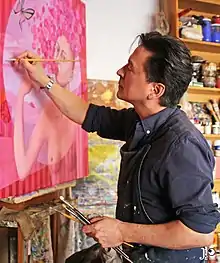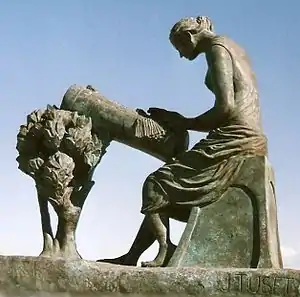Joan Tuset Suau
Joan Tuset i Suau (born in l'Arboç Tarragona Catalonia 19 December 1957) is an artist, painter, and sculptor.
Joan Tuset i Suau | |
|---|---|
 Joan Tuset in the workshop of l'Arboç. 2017 | |
| Born | 19 December 1957 |
| Nationality | Spanish |
| Known for | Painting, sculpture, |
| Movement | Figurative |
Career
He studied fine arts in Tarragona and Barcelona. His first painting exhibition was in 1976 in the city of Tarragona. During the 1980s Tuset moved to Canada,[1] where he lived for six years and exhibited at Edimage gallery, Joyce Yahouda Gallery,[2] and the Cultart Gallery. He also exhibited at the Art Institute of Chicago, and at 87 FIAC International Art Fair au Grand Palais of Paris.[3] In 1989, he moved to Paris, where he settled for six months and exhibited at Vison Quai Gallery.
These stages were a fundamental change in his life and work, as his figurative compositions gained more force and tension, and the characters of his works acquired a more classic basis, and his style was enriched with personal and expressive deformations. When he returned to Catalonia, he settled between L'Arboç, his hometown, and the city of Barcelona.
Painting
His years of pictorial research of the European masters, gave him a technical mastery of body and color, and a knowledge of space. He works with large monochrome or bichromatic areas that give his work a monumental sensation, with volumes that interact with the light and shadow of his characters, and in some works, light seems to originate from the bottom, and in others it is used to lighten faces and accentuate them with emotions.[4]
The central theme of Tuset's work is usually the human figure, its condition, its emotions, its daily environment, the passage of time and the psychology of art.[4]
The key to his inspiration lies in the tension that is generated within the psychological or emotional condition, which is usually the starting point of the processes and materials with which he finally decides to work.[4]
More recently, he has introduced in his work more complex and intellectualized reflections about his environment, the things that surround him, his workshop, his spirituality, his daily life, from which he takes ideas to create his art.[4]
Joan Tuset, talks about connecting to a world allowing him to “express his ideas and thoughts”, art serving “to express and communicate our innermost feelings, emotions, thoughts and experiences”.[5] Our exchange, the power of art to communicate complex ideas and feelings transpired, by the strong impulse it can provide to the human being, aiming to “create freely and transmit something that can only be understood from the need to think and live as an artist”. Concepts found, as put by Tuset, in the essence of art, as it consists of “learning to see, to be aware that we are here, that we are alive”,[6] and art helps to link our inner world with the outside world.[7]
Sculpture
His sculptures generally represent the human body and its forms are rounded and elegant. Many interpreters compare the undulating shape of their reclining bodies to the landscape of Catalonia.
He usually works in terracotta, plaster, bronze, or resin with marble powder, without giving up other materials that can enrich the final result of his work.
In 2005, he was commissioned to create the monument to the "Puntaire de L'Arboç" (typical emblematic figure of Catalonia), a work made in bronze that is located in one of the roundabouts of the National Highway 340, at the entrance of his hometown village, l'Arboç del Penedés (Tarragona), and was inaugurated by Josep Huguet, the Minister of Commerce and Tourism of the Government of the Generalitat de Catalunya in that time.[8]

Exhibitions
The artistic work of Tuset has been exhibited at both national and international level, and is exhibited in galleries in Montreal, Düsseldorf, Rome, Portugal, Paris, Tarragona, Girona, Barcelona, Valladolid and Salamanca. His work is represented in major public and private collections.
Main works
- Le sommeil, 1986. mixed media on canvas 132X229cm, Collection Lavalin, Montreal.
- Odalisca, 1987. mixed media on canvas 132X229cm, Collection Kauffman, Montreal.
- The Rape of Europa,[9] 1999. mixed media on canvas 60X60cm, Private collection, Barcellona.
- La lluna ofesa, 2002. mixed media on canvas 60X60cm, Private collection, Oviedo.
- La puntaire de l'Arboç, 2005. Bronze sculpture 200X200X84cm, Public Monument, Tarragona.
- El vi dels amants, 2012. mixed media on canvas 100X300cm, Private collection, Barcellona.
- The energy of memories, 2014. mixed media on canvas 50X150cm, Private collection, Barcelona.
Bibliography
- Dictionary "Ràfols" d'artistes contemporanis de Catalunya i Balears, 1989 Tomo IV pg.196.
- Dictionary "Ràfols" d'Artistes De Catalunya i Balears, Compendi Segle XX Tomo V, Art Network SL Barcelona 1998, pg.631.
- Artistas del Siglo XXI Guia Nacional Tomo v, Edicions Equador, Girona. pg.508–509.
- Guia Europea de Bellas Artes, Euro 2000, Edicions SL Benidorm (Alacant) pg.186.
- Quien i por què, Anales de las Artes Plasticas en el seglo XXI, Edita Art i Patrimoni, SA Madrid, pg. 725.
- Catàlego de la exposición, Artistes per a un nou segle 1996 a Canals Galeria d'art. S. Cugat, Barcelona.
- Amb L'Arboç com a teló de fons, de Rosa M ª Muntanya, 2005.Edición, Conselleria d'Hisenda i Festes Populars, pg.91.
- La Bisbal i les Puntes 2008, de Maria Plana Guasch. Edita Ajuntament de La Bisbal de Penedès, pgs.19i20.
- Diversos Perfils de Joana Maria Altet 2008.Editorial la Torratxa,Valls Tarragona.Pg.43
- Património imaterial e estatuária urbana 2013,de Ana Paula Gil Soares.Universidade de Lisboa,Faculdade de Letras.pg.24.
- Els béns culturals i l'Església 2010. Itinerari d'una experiència viscuda Arxiu i Museu diocesans de Barcelona J. M. Martí Bonet.pgs. 49,51,61.
- Los pintores y la pintura visto por profanos2017 author Manuel Roldán Pérez, pg.234-235.
- Los escultores y la escultura visto por profanos 2018 author Manuel Roldán Pérez pg. 218–219.
- Los oficios vistos en la pintura 2018 author Manuel Roldán Pérez pgs.99,115,118,138,141.
- Rescatant el vell arquetip de l'aranya 2018 author Joan Ramon Farré Huguet, pgs. 276, 277, 278, 279.
References
- https://www.joantuset.com/images/notespremsa/1983-1605-Finance_Montreal.pdf
- "Joyce Yahouda Gallery". joyceyahoudagallery.com. Retrieved 15 November 2016.
- https://www.joantuset.com/images/notespremsa/1989-2202-7a_Paris.pdf
- Ramon Ferran i Pagès, Lluís Vilà i Vendrell, Eduard Alentorn, Enric Monjo i Garriga (2011). Escultors Catalans Del Sud Contemporanis. General Books. ISBN 9781232740629.CS1 maint: multiple names: authors list (link)
- http://lnu.diva-portal.org/smash/get/diva2:1104185/FULLTEXT01.pdf Page 77
- http://lnu.diva-portal.org/smash/get/diva2:1104185/FULLTEXT01.pdf Page 51
- http://lnu.diva-portal.org/smash/get/diva2:1104185/FULLTEXT01.pdf Page 58
- "Joan Tuset i Suau - enciclopèdia.cat". enciclopedia.cat. Retrieved 15 November 2016.
- "Español: Mythological scene of the abduction of Europa". Retrieved 15 November 2016 – via Wikimedia Commons.